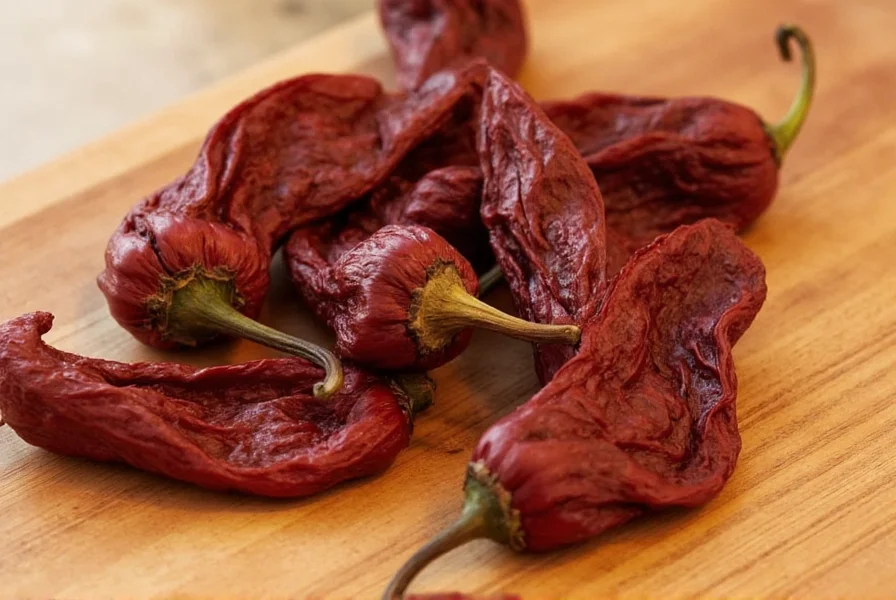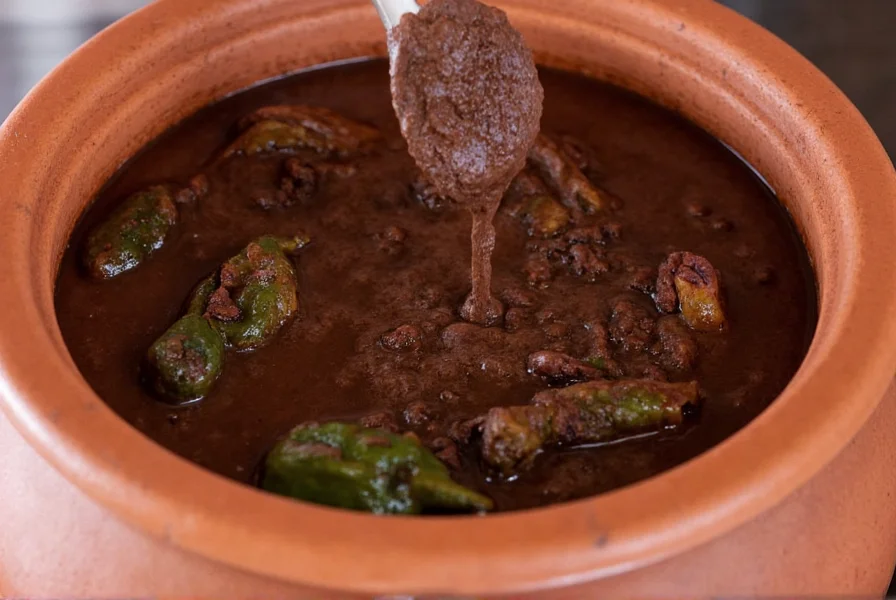Understanding dried poblano peppers unlocks authentic Mexican flavors in your cooking. These versatile chilies provide depth to sauces, stews, and marinades without overwhelming heat. When properly rehydrated or toasted, they release complex notes of dried fruit, cocoa, and subtle earthiness that fresh poblanos can't match. Chefs prize them for adding nuanced warmth rather than intense spiciness, making them ideal for dishes served to diverse palates.
What Exactly Is a Dried Poblano Pepper?
When poblano peppers reach full maturity and turn from dark green to deep red, they're harvested and slowly dried. This transformation creates what's commercially labeled as ancho peppers (from the Spanish "anchos," meaning wide). The drying process concentrates sugars while developing new flavor compounds through enzymatic reactions.
Unlike many dried chilies that become brittle, quality dried poblanos maintain some flexibility. They typically measure 4-6 inches long with a distinctive heart shape and wrinkled, mahogany-colored skin. The stem attachment point remains broad and flat, distinguishing them from similar dried chilies like guajillo or mulato.

Key Characteristics of Dried Poblano Peppers
Dried poblanos offer unique properties that make them indispensable in certain recipes. Their flavor profile combines:
- Earthy, tobacco-like notes
- Subtle sweetness reminiscent of dried plums
- Delicate smokiness (without actual smoke exposure)
- Floral undertones similar to raisins
- Mild heat that builds gradually
The Scoville rating of 1,000-2,000 units places them milder than jalapeños but with more complexity than bell peppers. This makes them perfect for dishes where you want chili flavor without dominating heat.
| Characteristic | Dried Poblano (Ancho) | Fresh Poblano |
|---|---|---|
| Color | Deep mahogany red | Dark green |
| Flavor Profile | Earthy, sweet, smoky, fruity | Grassy, vegetal, mild pepper |
| Heat Level | 1,000-2,000 SHU | 1,000-2,000 SHU |
| Texture | Leathery, pliable when quality | Crisp, thick-walled |
| Primary Use | Sauces, moles, stews | Chiles rellenos, roasting |
Proper Handling and Preparation Techniques
Maximizing flavor from dried poblano peppers requires proper preparation. Two primary methods exist for using them:
Rehydrating Dried Poblano Peppers
For sauces and stews requiring smooth texture:
- Remove stems and seeds (wear gloves to avoid skin irritation)
- Place in bowl and cover with hot water
- Weight down with small plate to keep submerged
- Soak 20-30 minutes until pliable but not mushy
- Drain and blend with soaking liquid for sauces
Dry-Toasting Dried Poblano Peppers
For enhanced flavor in salsas or spice blends:
- Heat dry skillet over medium heat
- Place whole peppers in skillet
- Toast 20-30 seconds per side until fragrant
- Immediately transfer to paper bag to steam briefly
- Remove skin if desired (optional for some recipes)
Never use oil when toasting dried chilies, as this can cause burning. The dry heat releases essential oils without scorching the delicate pepper skin.
Dried Poblano Pepper Substitutes
When you can't find dried poblanos, consider these alternatives for ancho pepper substitute options:
- Mulato peppers - Similar flavor with chocolate notes (slightly hotter)
- Guajillo peppers - Brighter fruit flavor, less earthy (use 1:1 ratio)
- Chipotle powder + sweet paprika (1:3 ratio) - For smoky applications
- Dried pasilla - Earthier profile, good for moles
Avoid substituting with significantly hotter chilies like arbol unless adjusting quantities dramatically. The unique sweet-earthy balance of dried poblanos makes direct substitution challenging.
Storage Recommendations for Longevity
Proper storage maintains flavor in your dried poblano pepper collection. Follow these guidelines:
- Store in airtight container away from light and heat
- Include silica gel packets to control moisture
- Keep whole rather than crushed until needed
- Refrigerate for extended storage (6-12 months)
- Freeze for maximum longevity (up to 2 years)
Check dried peppers periodically for signs of deterioration. Quality peppers should remain pliable with rich aroma. Discard if they become brittle, develop mold, or lose fragrance.
Nutritional Profile and Health Benefits
Dried poblano peppers retain significant nutritional value despite the dehydration process. Per 10g serving:
- 6 calories
- 1.3g dietary fiber (5% DV)
- Rich in vitamin A (15% DV)
- Good source of vitamin B6
- Contains capsaicinoids with antioxidant properties
The drying process concentrates certain nutrients while preserving capsaicin compounds associated with metabolic benefits. Unlike many processed ingredients, dried chilies maintain their phytochemical profile when properly stored.
Signature Recipes Featuring Dried Poblano Peppers
Chefs rely on dried poblanos for these classic applications:
Authentic Mole Poblano
The national dish of Mexico features dried poblanos as the flavor foundation. Combined with chocolate, sesame seeds, and spices, they create the complex sauce that defines this iconic dish. Properly prepared mole balances sweet, spicy, and earthy elements without any single note dominating.
Chile Colorado
This Northern Mexican staple uses rehydrated dried poblanos as the base for its rich, brick-red sauce. Simmered with garlic and cumin, it creates the perfect coating for tender beef in this beloved comfort food.
Smoky Salsa de Árbol
While árbol peppers provide heat, dried poblanos add depth and body to this versatile salsa. The combination creates a balanced condiment suitable for everything from eggs to grilled meats.

Where to Source Quality Dried Poblano Peppers
Finding authentic dried poblano peppers near me requires knowing what to look for:
- Specialty Mexican markets typically carry the freshest stock
- Look for pliable texture rather than brittle specimens
- Choose peppers with deep, uniform color (avoid faded specimens)
- Smell for rich, earthy aroma (musty smell indicates age)
- Consider online retailers specializing in Mexican ingredients
When evaluating quality, remember that dried poblanos should feel leathery, not crumbly. The best specimens come from Mexico's Puebla region, where the pepper originated and gives mole poblano its name.
Frequently Asked Questions
What's the difference between ancho peppers and dried poblano peppers?
There is no difference—they're the same product. Ancho is the name given to poblano peppers after they've been dried. When fresh poblanos mature to red and undergo dehydration, they become anchos. The name "ancho" refers specifically to their wide shape.
Can I substitute fresh poblano peppers for dried in recipes?
Not directly. Fresh and dried poblanos have fundamentally different flavor profiles and water content. For every 4 dried anchos, you'd need approximately 8 fresh poblanos roasted and peeled. The flavor won't be identical, as drying develops complex sugars and compounds that fresh peppers lack.
How long should I soak dried poblano peppers before using?
Soak dried poblano peppers in hot water for 20-30 minutes until they become pliable but not mushy. Test by bending—a properly rehydrated pepper should flex without cracking. For blender applications, 25 minutes typically provides optimal texture for smooth sauces.
Why do some recipes call for removing seeds from dried poblanos?
While dried poblano seeds contain most of the heat, they can also impart bitterness when blended. Removing seeds creates a smoother, more balanced flavor profile essential for delicate sauces like mole. For rustic salsas where texture matters less, many chefs keep the seeds for additional heat.
How can I tell if my dried poblano peppers have gone bad?
Dried poblanos have spoiled if they've become brittle and crumble when touched, developed mold (visible as white fuzz), or lost their characteristic earthy aroma. Properly stored dried peppers should remain pliable and fragrant for 6-12 months in a cool, dark place.











 浙公网安备
33010002000092号
浙公网安备
33010002000092号 浙B2-20120091-4
浙B2-20120091-4